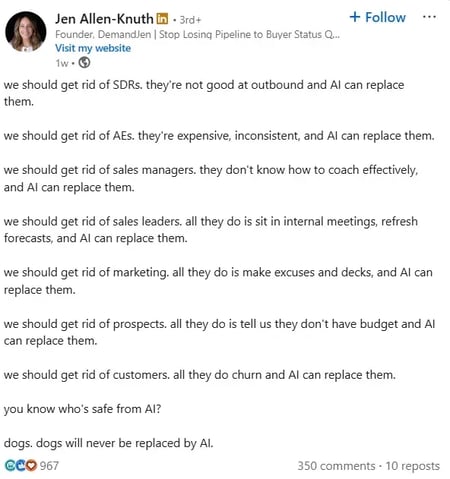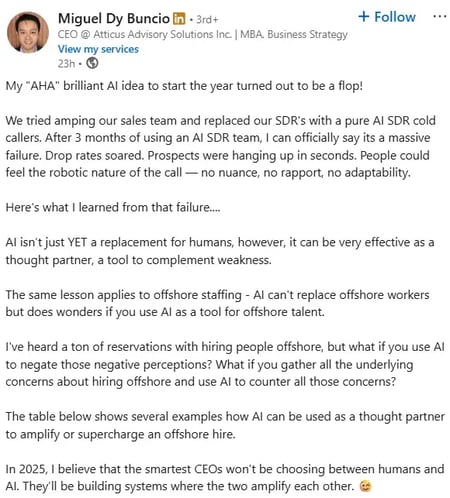If you’re like me, you’ve asked this question: What is the difference between a salesperson and a business development representative (BDR)? Well, here’s what I found. A salesperson usually deals with warm leads. That is, people who already know what they want and just need some guidance to make a decision. But a BDR? That’s outbound territory.
They’re the ones doing the digging, researching prospects, identifying opportunities, and building a pipeline of potential clients from scratch. They’re the ones picking up the phone, sending those cold emails, and sparking interest where there was none.
After nearly a decade of hunting down leads for my business, I’ve become a one-person business development team. Now, here’s the kicker. AI means the hours I’ve spent researching leads and trying to break through the noise may be automated. Efficiently. At scale.
Naturally, I had to investigate.
Read on to discover what I found about AI BDRs and how they are changing the game.
Table of Contents
- What is an AI business development representative?
- How AI BDRs Work
- Can AI BDRs replace human reps?
- Why hire an AI BDR?
- Best AI BDR Agents and Tools
What is an AI business development representative?
Let’s be honest. These days, “AI” is pretty much prefixed to everything from toothbrushes to to-do lists. So, before we get swept up in the buzzwords, I like to break things down. First, let’s strip it back to basics. Who is a BDR?
According to , a BDR is “responsible for generating new business opportunities by qualifying leads and prospecting through existing business accounts to engage with potential buyers.”
In simple terms, they’re the ones who research, reach out, and start conversations that (hopefully) lead to sales. Now, let’s bring AI into the mix. At its core, artificial intelligence is here to automate, augment, or optimize tasks, especially those that are repetitive or data-heavy.
So, when we put the two together, here’s what we get:
An AI BDR is a software agent that uses artificial intelligence to automate and optimize core and repetitive business development tasks, such as prospecting, lead qualification, and outreach, with the goal of generating new business opportunities at scale.
-Mar-14-2025-05-55-40-8841-PM.png)
Free AI Agents Playbook
This practical guide reveals where to start, which applications deliver real value, and how to implement agents that transform workflows without replacing jobs.
- Marketing Workflow Automation
- Sales Acceleration System
- Operational Excellence
- Implementation Blueprint
Download Free
All fields are required.
-Mar-14-2025-05-55-40-8841-PM.png)
You're all set!
Click this link to access this resource at any time.
How AI BDRs Work
Like many AI solutions, AI BDRs use machine learning and natural language processing (NLP) to mimic parts of the BDR process and replicate it with incredible speed and scale. Now, what does a typical BDR process look like? In 2020, what a typical day in their lives looked like.
kicked things off with what might sound simple but is essential — getting coffee, checking his calendar, and getting mentally prepared for the day ahead. shared that she spends her mornings sourcing companies she plans to reach out to, while mentioned her work phone had “basically become [her] best friend” thanks to the number of calls she makes each day.
Then there’s the deeper work. talked about connecting with clients and learning about their business models, and described filtering through inbound leads to find the best-fit accounts. She says, “I go filter through all of the inbound leads that 探花精选 generates through the back of its really excellent blog content and from there, I will find the best-fit leads.”
, on the other hand, focused on administrative tasks that involved follow-ups and making sure prospects were armed with the right information before they talked to an account executive.

What’s interesting is how many of these tasks (calendar checks, lead sourcing, phone outreach, research, or even follow-ups) are now supported by AI sales tools, and have now formed a core part of the AI BDR offerings.
- Where Thng once manually sourced companies to contact, AI tools can now use predictive analytics to pre-select prospects based on firmographics, buying signals, and engagement history. AI will also leverage the same technologies to support BDRs like Stamp to filter high-intent inbound leads automatically.
- Where Brillaud prepares her follow-up emails, natural language tools can draft emails tailored to the lead’s industry or behavior.
- For someone like Uchida, whose day revolves around calls, AI can quietly sit in, transcribe the conversation, and flag key moments which would save time and boost productivity.
- AI BDRs can also optimize calendar and workflow planning for BDRs like Brito, setting priorities based on lead scoring and urgency, especially when integrated with .
- Providing administrative support is unarguably AI’s domain. These days, AI BDRs can fully automate follow-up workflows, provide tailored content recommendations, and log every interaction into the CRM automatically. 2020 Brillaud would be grateful for that.
If AI is so wonderful at BDR, it begs the question …
Can AI BDRs replace human reps?
Uh, no.
And I’ll explain why.
When asked whether AI BDRs can replace human reps, , founder of , counters with this. “Can AI ever sell as well as humans do?” His answer? Not really.
As Reinoso (and I agree), the heart of real selling lies in “showing true empathy, building trust, and forging human-to-human connections.” He drives the point home with a memorable analogy. “In sales, AI will always be playing checkers while humans are playing chess.”
Cue this funny but true by :

But don’t take just mine, Allen-Knuth’s, or Reinoso’s word for it. According to , 82% of salespeople (including BDRs) agree that while AI tools reduce manual tasks, building strong relationships is still the most critical and rewarding part of the job. It’s not just about sending emails or qualifying leads, it’s about understanding people and being able to connect in a way that can’t be replicated by code.
And buyers feel the same.
探花精选’s research also found that 96% of prospects do their own research before ever talking to a rep, which means by the time they get to you, they’ve already read the blog posts, watched the demos, and compared your product to others (if you cared to put that online, of course).
What they’re looking for now isn’t information, it’s resonance. Something to click. Someone who gets it. And that’s where human BDRs shine.
Even subtle things like referencing a past conversation, a mutual connection, or any prior contact can dramatically increase trust and engagement. According to industry benchmarks, referencing prior interactions can improve lead conversion rates . That context, that tailored relevance, it’s all deeply human.
Now, that’s not to say AI BDRs don’t have a place. AI BDRs are incredible at the repetitive, tedious, admin-heavy stuff — and this is why there is a record increase in AI adoption in sales. They can find leads, sort them, score them, and even kick off the first wave of outreach.
However, , co-founder of Koala, against going all-in on automation too soon. “I think we’re seeing a pulling back on AI SDRs just because they’re not quite hitting the mark on really thoughtful, genuinely helpful context. At the end of the day, if you’re not offering value in that outbound message, you’re not gonna book a meeting. And a lot of the AI SDRs have kind of fallen short of that promise.”
Bottom line? Until AI BDRs can connect with people on an emotional level, until they can read the room, adapt, and build trust in real time, they’re here to assist, not replace.
And honestly, that’s probably the best-case scenario. As Michael Brown, Columbia Business School professor, says in an , “I don’t know any buyer who wants to be sold to by a copilot.”
Unfortunately, this CEO the hard way:

Why hire an AI BDR?
Now that we’ve established what AI BDRs are good at, let’s look at what they actually do for your business and why it matters.
1. They take over the manual tasks (so your team can actually sell).
No one wants a BDR who just clocks in, makes 50 calls from a spreadsheet of 7,000 cold leads, and checks out for the day. Real business development isn’t about mass dialing. It’s about value-based outreach.
AI BDRs step in to handle the grunt work — researching leads, scoring them based on fit and intent, etc., so your human reps can focus on conversations that convert. Take , a creative content design platform, for example. , their sales process became tangled in disconnected systems and bloated spreadsheets.
According to , director of revenue operations, “Our approach to prospecting was ‘volume over value.’ Our systems and processes got so complex and disjointed. Our reps were wasting time and lacking insight. Their productivity tanked. They were playing darts in the dark. The worst part: Our customers suffered as a result. Because reps were so bogged down, they lost sight of what they do best: actually connecting with prospects.”
Ceros adopted , streamlining workflows and surfacing key insights directly within contact records. No more digging through tabs. With AI-driven automation, reps could zero in on diagnosing pain points and driving deals forward.
The result? A 180% increase in deals generated and a greater than 18% growth in sales qualified leads over five years. Proof that giving reps time back equals serious pipeline growth.
2. They enhance client conversations by making reps smarter.
Even the most experienced reps won’t be experts in every vertical. But AI can help them sound like they are. Take , a Salesforce seller who with a customer in the electric vehicle charging space, a topic she wasn’t familiar with.
She instead turned to Salesforce’s Agentforce AI to help her prep. “I don’t have a vertical, so I’m no industry expert in regards to electric vehicle contracting,” she said. To prepare for the call, she asked her AI sales agent for relevant info regarding the business (industry trends, call recordings, previous sales, etc.).
“That’s a way for me to really quickly get up to speed on who this customer is. What were the previous conversations with Salesforce? Who are the key stakeholders?” Working remotely from Pittsburgh, Gault emphasized how AI tools help her prepare for meetings when she doesn’t have colleagues nearby to role-play with or bounce ideas off.
These kinds of AI tools also support personalization and consistency, ensuring reps bring relevant context into every call. As one B2B sales rep put it in a , “Thanks to AI tools, buyers know more about my products, and I know more about their needs.”
3. They never forget to follow up.
Here’s a stat every sales leader knows deep down: 80% of deals require at least five follow-ups, but 94% of reps give up before that fifth attempt. Why? It’s not a lack of hustle. It’s a lack of capacity. Reps are juggling many conversations, calendars, and tools. Eventually, some leads just fall through the cracks.
AI BDRs handle the ongoing follow-up with surgical precision — sending the right message at the right time, based on behavior, engagement, and context. is a prime example. After growing their leads from 750 to 4,000 using , they hit a wall.
According to , VP of sales, “It worked great until it didn’t. Leads fell through the cracks. Sometimes delayed by weeks. Suddenly, I was playing IT guy instead of focusing on strategy.”
Once they integrated , everything changed. Reps now get real-time alerts when a lead clicks an email or visits the site, and all relevant engagement data is instantly available.
Their outreach is now timely, tailored, and data-backed. And the growth speaks for itself, “Our people are growing with the business,” says Morris. “We’ve gone from 12 clubs to 23, and we’re just getting started.”
4. They scale what humans can’t.
AI doesn’t get tired, distracted, or discouraged, and that’s a huge advantage in high-volume outreach. As , VP of marketing at , explains, “AI is unbeatable at consistency, follow-through, and scale.”
Vendict — an AI-native government, risk, and compliance solution — built their own in-house AI BDR “Maya” as a core part of their go-to-market stack. Maya qualifies inbound leads, runs outbound campaigns, powers web chat, and supports sales enablement, all without dropping a ball.
“Maya never forgets a lead, never misses a follow-up, and doesn’t get discouraged when someone ghosts her,” says Kubovski. Interestingly, she’s noticed that some prospects actually prefer talking to Maya first.
“She offers prospects a lower-pressure way to engage. Some people actually prefer chatting with a bot first — it feels safer, more on their terms, and helps them avoid the early-stage sales pressure they’d rather skip. That lowers the barrier to entry and increases reply rates, especially in complex or crowded markets.”
-Mar-14-2025-05-55-40-8841-PM.png)
Free AI Agents Playbook
This practical guide reveals where to start, which applications deliver real value, and how to implement agents that transform workflows without replacing jobs.
- Marketing Workflow Automation
- Sales Acceleration System
- Operational Excellence
- Implementation Blueprint
Download Free
All fields are required.
-Mar-14-2025-05-55-40-8841-PM.png)
You're all set!
Click this link to access this resource at any time.
Best AI BDR Agents and Tools
Here are some of the AI BDR agents and tools moving the needle right now.
Disclaimer: The terms AI BDR and AI SDR (sales development representatives) are often used interchangeably, especially when the platform/tool handles outbound prospecting since both roles overlap in driving pipeline through the early stages.
1.
What it does: Breeze is built into 探花精选’s Sales Hub and is designed to research, score leads, personalize outreach, and optimize follow-up timing. Fully integrated with 探花精选’s CRM, it allows reps to run AI-powered workflows inside a unified platform — from discovery to outreach to scheduling.
In a by , CEO at Glare Marketing Technologies, she shares, “I’ve been working with the Breeze Prospecting Agent for two weeks, and I’m genuinely impressed. It’s not just about automation — it’s about efficiency and consistency in how we engage with prospects. Whether reaching out to high-value accounts or keeping lower-priority segments engaged, this tool has got you covered.”
What I like: It’s deeply integrated into the 探花精选 ecosystem, which means CRM data, contact history, and templates are all centralized, making personalization far more effective. Also, it sticks to what AI does best: research, automation, and data monitoring and analysis — without overpromising what AI can’t yet do.
Pricing: Included in Sales Hub Professional and Enterprise tiers (starting from $90–$150 per seat/month).
2.
![]()
What it does: Ava is a fully autonomous outbound AI SDR that handles everything from email and LinkedIn campaigns to leaving voicemails and qualifying leads. It can send hundreds of personalized messages at scale and integrates directly with your CRM.
Despite controversy over its bold , Artisan claims the campaign generated .
Recently, the founder, , shared that they would be doubling down on Ava’s capabilities by introducing new intent triggers to surface in-market leads at the right moment, data enrichment from customers’ existing CRM to help uncover untapped segments, additional outreach channels for more diversified prospecting and self-optimizing messaging, using AI to improve response rates over time.
What I like: There’s something both eerie and strangely reassuring about interacting with AI tools that have avatars, and Ava leans into this personality-driven design.
Beyond aesthetics, Ava is backed by a massive database of 300 million contacts and more than 65 targeting filters, making it incredibly flexible for outbound. It also features automated email deliverability management — adjusting timing, sender identity, and message structure to avoid spam folders and maintain high inbox placement.
Pricing: Pricing depends on the number of leads you’re targeting and your outreach volume. Artisan splits this between BDR and AE seats. You’ll need to book a consultation for specific pricing.
3.

What it does: Eve is an AI sales assistant designed for natural, two-way conversations, especially via email, voice, and SMS. It uses Conversica’s proprietary Large Language Model, Automatic Speech Recognition, and Natural Language Understanding to sound impressively human. Eve qualifies leads, conducts follow-ups, updates CRMs, and speaks over 120 languages.
What I like: It’s one of the few tools that truly sounds natural in cold-call-like interactions. A great fit for teams that need AI to handle early-stage conversations or scale multilingual outreach.
Pricing: Custom quote required.
4.

What it does: Bosh is a customizable AI sales agent from Relevance AI’s no-code platform. You can train it using your own product data, and it will manage end-to-end workflows: prospecting, conversations, scheduling, and CRM updates. It also features SOC 2 compliance and data privacy controls.
What I like: Its privacy-first approach is a standout, ensuring none of your proprietary data is used to train external models. It’s also highly customizable and integrates with over 20 platforms.
Pricing: Pricing via sales consultation.
5.
![]()
What it does: Jason is a sales agent within Reply.io that leverages over 1 billion real-time data points. It handles prospecting, personalized outreach, multichannel campaigns (email, LinkedIn, SMS), and automatic follow-up. Jason also helps define your ICP and adapts messaging accordingly.
What I like: Jason’s ability to auto-generate and refine ICPs using your value prop is powerful for lean sales teams. You can also toggle between autopilot and copilot modes for response automation, depending on how much control you want over messaging.
Pricing: Starts at $300/month for 500 active contacts. Higher tiers (e.g., 50,000 contacts) are $15,000/month.
Say hello to AI-assisted human selling.
More than 40% of sales professionals already use AI at work, and 76% believe that by 2030, most people will rely on some form of AI or automation to assist them in their jobs. From what I’ve gathered, that’s not just a prediction. It’s reality. Having AI BDRs handle routine outreach will give you back hours in your week — hours you can pour back into the work that makes a real difference for your company.
But before you start, Kubovski offers some guidance. “Start by building the foundation — don’t rush into automating. That means defining your messaging, audience, and the kind of conversations you actually want to have. We trained Maya first: Not just on email syntax, but on how we talk about our product, who we’re selling to, and what they care about.
“So, whether you’re launching an AI BDR or automating compliance workflows, the advice is the same: Invest in context before you invest in execution. That’s how you make AI feel less like a shortcut — and more like a smart teammate.”
-Mar-14-2025-05-55-40-8841-PM.png)
Free AI Agents Playbook
This practical guide reveals where to start, which applications deliver real value, and how to implement agents that transform workflows without replacing jobs.
- Marketing Workflow Automation
- Sales Acceleration System
- Operational Excellence
- Implementation Blueprint
Download Free
All fields are required.
-Mar-14-2025-05-55-40-8841-PM.png)
You're all set!
Click this link to access this resource at any time.
-Mar-14-2025-05-55-40-8841-PM.png?width=112&height=112&name=Featured%20Image%20(1)-Mar-14-2025-05-55-40-8841-PM.png)


![13 Ways AI Can Benefit Your Business [+ New Data and Gen AI Prompts]](https://53.fs1.hubspotusercontent-na1.net/hubfs/53/benefits-of-business-in-ai-1-20241113-8880073.webp)







